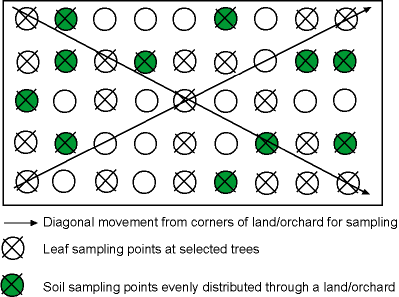Completion requirements
View
A single leaf or soil sample should be representative of an area not greater than 3 ha, but this can depend on the crop size planted. However, if there is soil variations separate leaf and soil samples must be taken and the orchard management adapted accordingly.


Click here to view a video that explains leaf sampling.
Taking representative soil and leaf samples from orchards as per example:
- The time of leaf sampling as well as leaf position is very important and is shown in the figure. Leaf analysis is only applicable for producing mango trees (normally a tree age of 5 years and older).
- Select about 20 healthy trees by walking diagonally from the corners through the orchard (see figure). The trees should be homogeneous in appearance and representative of the orchard.
- Exceptionally good or poor trees must not be sampled.
- The 20 selected trees must be clearly marked, for example with paint, so that both the soil and leaf samples can be taken from the same trees every year.
- Where possible, pick 4 leaves from alternate sides of the tree at about shoulder height. Eighty leaves per sample should be sufficient.
- Different cultivars should be sampled separately.
- Leaves sampled must be free of sunburn, disease and insect damage.
- Leaf samples should be collected in the morning after the dew has dried off.
- Leaf samples should not be taken if trees are under stress, i.e. drought or high temperatures. After a heavy downpour, wait at least 2 weeks before taking samples.
- After sampling, leaves should be placed in clean, perforated or open plastic bags.
- If samples cannot be delivered immediately (within 48 hours), they can be stored in a refrigerator and should be transported in a cooler bag. The sample must be accompanied by the relevant orchard information including previous production figures, tree age and fertiliser programs of the past. Any problems concerning the specific orchard, such as small fruit, should be mentioned.
Leaf Sampling Procedures
- Obtain plant analysis mailing kit from the area laboratory agent’s office. One mailing kit per sample is required.
- Sample trees between July 7th and August 7th. (Sampling can be extended into mid-August without affecting the results.)
- Collect 100 middle-pair of leaflets from the middle leaf of this year’s growth (see illustration). Use terminal shoots exposed to the sun. Avoid twigs from the interior of the tree. Collect leaflets from all sides of the tree. Avoid leaflets damaged by insects and diseases.
- Abnormal trees or trees not representative of the area should be sampled and sent separately. A complete and accurate description of abnormalities should accompany such samples.
- Sample trees of the predominant variety in a given block. If Schley is the main variety, sample Schley, if Stuart is the main variety, then sample Stuart, etc.
- Immediately upon collection, wipe leaves (entire surface, both top and bottom) with a damp cellulose sponge or cheesecloth to remove dust and spray residue. Do not allow the leaves to come into contact with rubber or galvanized containers. Partially air dry and place in the large envelope of the mailing kit.
- Complete the questionnaire obtained.
- If recent soil test data were not available, it would be advisable to collect a soil sample and have it sent to the Soil Testing Laboratory.